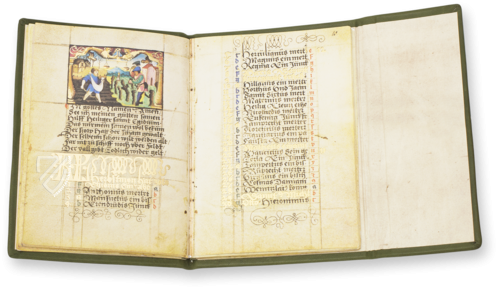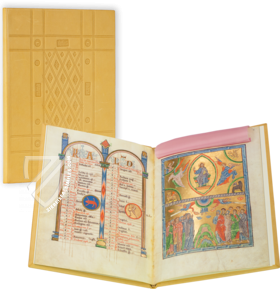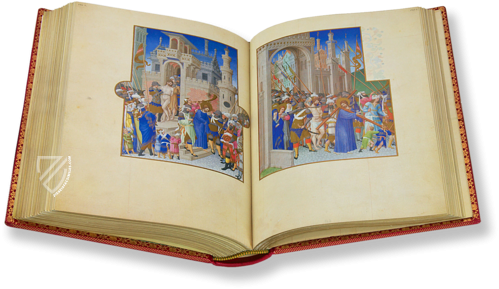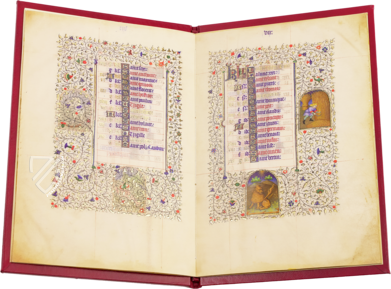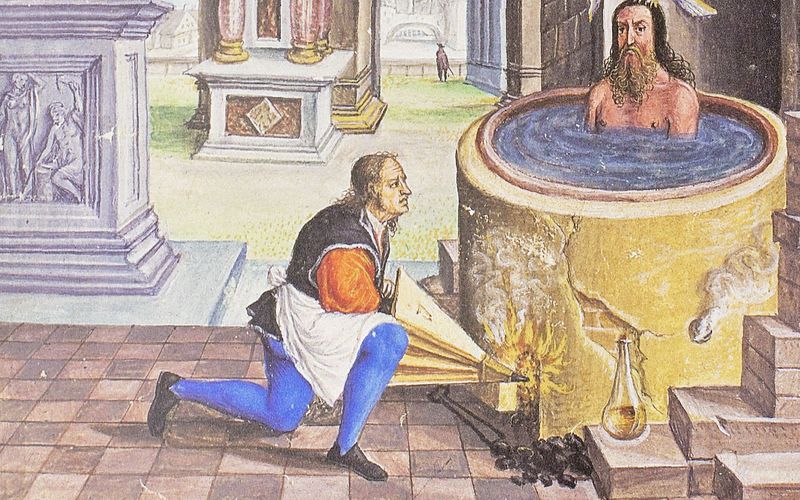The Golden Calendar (Collection)
(under 1,000€)
The calendar sections of medieval manuscripts gradually became more elaborate throughout the Middle Ages, with Late Gothic and Renaissance manuscripts often featuring elaborate scenic depictions. These presented an activity typical for the month, usually reflecting the region in which they were made, in addition to the respective zodiac sign or even constellations. In addition to their artistic value, medieval calendars are historically significant because of their evolution from the Roman calendar system to something resembling our modern system in manuscripts from the Late Middle Ages. The single-leave collection The Golden Calendar comprises 13 beautiful calendar pages from particularly splendid, artful and famous manuscripts of the 15th and 16th centuries - from the Très Riches Heures du Duc de Berry to Simon Bening's Flemish Calendar and the Golden Calendar of Albert Glockendon. They cover every month. The collection is completed by a gorgeous astrological full-page miniature.
The Golden Calendar
The medieval calendar was different from the modern one, having more in common with the ancient Roman calendar until the end of the medieval period. Documents were dated according to regnal years, and the AD system was not introduced until the High Middle Ages. Many medieval manuscripts featured a calendar section, but they were particularly common in the books of hours that became popular during the Late Middle Ages. During the increasingly secular Renaissance, so-called calendar books emerged, which contained a calendar without prayer texts and might be appended by other helpful information in tables. These calendar pages often featured one or more miniatures rendered in expensive paints and gold leaf, usually in the form of medallions or marginalia, which would depict either a major holiday from the month, e.g. commemorating a saint’s martyrdom, the corresponding zodiac sign, or a typical labor of the month, e.g. shearing sheep, harvesting grain, or pressing wine. This last decorative element makes these calendar pages a priceless resource on daily life in the Middle Ages, not only for the activities they portray, but also for the various tools and other objects which are detailed therein. As such, calendar pages are among the most beloved specimens of medieval art.
The 13 single pages presented here represent some of the finest specimens of illuminated medieval calendars to survive to the present:
Folio 1: January – Bedford Hours, Paris, ca. 1423–1430
Folio 2: February – Les Très riches Heures du Duc de Berry, Paris, ca. 1413
Folio 3: March – Rohan Hours, France ca. 1420
Folio 4: April – Book of Hours of James IV, Ghent (Bruges), ca. 1503–1513
Folio 5: May – Flemish Book of Hours, Flanders, ca. 1515
Folio 6: June – Les Très riches Heures du Duc de Berry, Paris um 1413
Folio 7: July – Golden Calendar of Albert Glockendon, Nuremberg, 1526
Folio 8: August – Breviarium Grimani, Bruges, ca. 1520
Folio 9: September – Black Prayer Book of Galeazzo Maria Sforza, Bruges, ca. 1466–1476
Folio 10: October – Hours of Mary of Burgundy, Ghent, ca. 1467–1480
Folio 11: November – Simon Bening’s Flemish Calendar, Bruges, ca. 1540
Folio 12: December – Rohan Hours, France, ca. 1420
Folio 13: The Anatomical Zodiac Man – Les Très riches Heures du Duc de Berry, Paris, ca. 1413
Codicology
- Alternative Titles
- Kassette Der Goldene Kalender
- Origin
- France
- Date
- 15th–16th century
- Epochs
- Style
- Genre
- Illustrations
- 13 miniatures
- Content
- Thirteen leaves from important manuscripts
Les Très riches Heures du Duc de Berry
The Anatomical Zodiac Man
The so-called “Zodiac Man” was common in medieval calendars, books of hours, and treatises on philosophy, astrology, and medicine. Rooted in ancient medicine going back to the Babylonians, medieval physicians believed that there was a connection between the cosmos (macrocosm) and the human body (microcosm). Furthermore, they associated particular body parts with zodiac signs and planned procedures based upon the cosmos, especially the moon, whose effects on the tides are self-evident.

Black Gospels
September – Wine Pressing
Black-dyed parchment was extremely expensive in the Middle Ages, and here we see one of the finest examples of this rare material. Having a dark background allows the artist to exploit gold and silver ink to the greatest extent possible. Although written in an elaborate hand, the letters are executed with such precision so as to make them easily legible.
Even more impressive are the two medallion miniatures at the top of the page. On the left, a man in a fine red coat tied at the waste with a golden belt stomps on grapes in a great golden vat. Holding the scales on the right and dressed in a flowing golden dress, we see the Greek Titaness Themis, an ancient symbol of natural law and divine order associated with the zodiac sign Libra.

#1 Kassette Der Goldene Kalender
Language: German
(under 1,000€)
- Treatises / Secular Books
- Apocalypses / Beatus
- Astronomy / Astrology
- Bestiaries
- Bibles / Gospels
- Chronicles / History / Law
- Geography / Maps
- Saints' Lives
- Islam / Oriental
- Judaism / Hebrew
- Single Leaf Collections
- Leonardo da Vinci
- Literature / Poetry
- Liturgical Manuscripts
- Medicine / Botany / Alchemy
- Music
- Mythology / Prophecies
- Psalters
- Other Religious Books
- Games / Hunting
- Private Devotion Books
- Other Genres
- Afghanistan
- Armenia
- Austria
- Belgium
- Colombia
- Croatia
- Cyprus
- Czech Republic
- Denmark
- Egypt
- Ethiopia
- France
- Germany
- Greece
- Hungary
- India
- Iran
- Iraq
- Israel
- Italy
- Japan
- Lebanon
- Luxembourg
- Mexico
- Morocco
- Netherlands
- Palestine
- Peru
- Poland
- Portugal
- Russia
- Serbia
- Spain
- Sri Lanka
- Sweden
- Switzerland
- Syria
- Turkey
- Ukraine
- United Kingdom
- United States
- Uzbekistan
- Aboca Museum
- Ajuntament de Valencia
- Akademie Verlag
- Akademische Druck- u. Verlagsanstalt (ADEVA)
- Aldo Ausilio Editore - Bottega d’Erasmo
- Alecto Historical Editions
- Alkuin Verlag
- Almqvist & Wiksell
- Amilcare Pizzi
- Andreas & Andreas Verlagsbuchhandlung
- Archa 90
- Archiv Verlag
- Archivi Edizioni
- Arnold Verlag
- ARS
- Ars Magna
- ArtCodex
- AyN Ediciones
- Azimuth Editions
- Badenia Verlag
- Bärenreiter-Verlag
- Belser Verlag
- Belser Verlag / WK Wertkontor
- Benziger Verlag
- Bernardinum Wydawnictwo
- BiblioGemma
- Biblioteca Apostolica Vaticana (Vaticanstadt, Vaticanstadt)
- Bibliotheca Palatina Faksimile Verlag
- Bibliotheca Rara
- Boydell & Brewer
- Bramante Edizioni
- Bredius Genootschap
- Brepols Publishers
- British Library
- C. Weckesser
- Caixa Catalunya
- Canesi
- CAPSA, Ars Scriptoria
- Caratzas Brothers, Publishers
- Carus Verlag
- Casamassima Libri
- Chavane Verlag
- Christian Brandstätter Verlag
- Circulo Cientifico
- Club Bibliófilo Versol
- Club du Livre
- CM Editores
- Collegium Graphicum
- Collezione Apocrifa Da Vinci
- Comissão Nacional para as Comemorações dos Descobrimentos Portugueses
- Coron Verlag
- Corvina
- CTHS
- D. S. Brewer
- Damon
- De Agostini/UTET
- De Nederlandsche Boekhandel
- De Schutter
- Deuschle & Stemmle
- Deutscher Verlag für Kunstwissenschaft
- DIAMM
- Droz
- E. Schreiber Graphische Kunstanstalten
- Ediciones Boreal
- Ediciones Grial
- Ediclube
- Edições Inapa
- Edilan
- Editalia
- Edition Deuschle
- Edition Georg Popp
- Edition Leipzig
- Edition Libri Illustri
- Editiones Reales Sitios S. L.
- Éditions de l'Oiseau Lyre
- Editions Medicina Rara
- Editorial Casariego
- Editorial Mintzoa
- Editrice Antenore
- Editrice Velar
- Edizioni Edison
- Egeria, S.L.
- Eikon Editores
- Electa
- Emery Walker Limited
- Enciclopèdia Catalana
- Eos-Verlag
- Ephesus Publishing
- Ernst Battenberg
- Eugrammia Press
- Extraordinary Editions
- Fackelverlag
- Facsimila Art & Edition
- Facsimile Editions Ltd.
- Facsimilia Art & Edition Ebert KG
- Faksimile Verlag
- Feuermann Verlag
- Folger Shakespeare Library
- Franco Cosimo Panini Editore
- Friedrich Wittig Verlag
- Fundación Hullera Vasco-Leonesa
- G. Braziller
- Gabriele Mazzotta Editore
- Gebr. Mann Verlag
- Gesellschaft für graphische Industrie
- Getty Research Institute
- Giovanni Domenico de Rossi
- Giunti Editore
- Graffiti
- Grafica European Center of Fine Arts
- Guido Pressler
- Guillermo Blazquez
- Gustav Kiepenheuer
- H. N. Abrams
- Harrassowitz
- Helikon
- Hendrickson Publishers
- Henning Oppermann
- Herder Verlag
- Hes & De Graaf Publishers
- Hoepli
- Holbein-Verlag
- Hortus Deliciarum
- Houghton Library
- Hugo Schmidt Verlag
- Idion Verlag
- Il Bulino, edizioni d'arte
- ILte
- Imago
- Insel Verlag
- Instituto Nacional de Antropología e Historia
- Istituto dell'Enciclopedia Italiana - Treccani
- Istituto Ellenico di Studi Bizantini e Postbizantini
- Istituto Geografico De Agostini
- Istituto Poligrafico e Zecca dello Stato
- Italarte Art Establishments
- J. Thorbecke
- Jan Thorbecke Verlag
- Johnson Reprint Corporation
- Josef Stocker
- Josef Stocker-Schmid
- Jugoslavija
- Karl W. Hiersemann
- Kasper Straube
- Kaydeda Ediciones
- Kindler Verlag / Coron Verlag
- Kodansha International Ltd.
- Konrad Kölbl Verlag
- Kurt Wolff Verlag
- La Liberia dello Stato
- La Linea Editrice
- La Meta Editore
- Lambert Schneider
- Landeskreditbank Baden-Württemberg
- Leo S. Olschki
- Les Incunables
- Library of Congress
- Libreria Musicale Italiana
- Lichtdruck
- Lito Immagine Editore
- Lumen Artis
- Lund Humphries
- M. Moleiro Editor
- Maison des Sciences de l'homme et de la société de Poitiers
- Manuscriptum
- Martinus Nijhoff
- Maruzen-Yushodo Co. Ltd.
- MASA
- McGraw-Hill
- Militos
- Millennium Liber
- Müller & Schindler
- Nahar and Steimatzky
- National Library of Wales
- Neri Pozza
- Nova Charta
- Oceanum Verlag
- Odeon
- Orbis Mediaevalis
- Orbis Pictus
- Österreichische Staatsdruckerei
- Oxford University Press
- Pageant Books
- Parzellers Buchverlag
- Patrimonio Ediciones
- Pattloch Verlag
- PIAF
- Pieper Verlag
- Plon-Nourrit et cie
- Prestel Verlag
- Princeton University Press
- Prisma Verlag
- Priuli & Verlucca, editori
- Pro Sport Verlag
- Propyläen Verlag
- Pytheas Books
- Quaternio Verlag Luzern
- Reales Sitios
- Recht-Verlag
- Reichert Verlag
- Reichsdruckerei
- Riehn & Reusch
- Roberto Vattori Editore
- Rosenkilde and Bagger
- Roxburghe Club
- Salerno Editrice
- Sarajevo Svjetlost
- Schöck ArtPrint Kft.
- Scolar Press
- Scrinium
- Scripta Maneant
- Scriptorium
- Siloé, arte y bibliofilia
- SISMEL - Edizioni del Galluzzo
- Sociedad Mexicana de Antropología
- Société des Bibliophiles & Iconophiles de Belgique
- Soncin Publishing
- Sorli Ediciones
- Stainer and Bell
- Studer
- Styria Verlag
- Sumptibus Pragopress
- Szegedi Tudomànyegyetem
- Taberna Libraria
- Tarshish Books
- Taschen
- Tempus Libri
- Testimonio Compañía Editorial
- Thames and Hudson
- The Clear Vue Publishing Partnership Limited
- The Facsimile Codex
- The Folio Society
- The Marquess of Normanby
- The Richard III and Yorkist History Trust
- Tip.Le.Co
- TouchArt
- TREC Publishing House
- TRI Publishing Co.
- Trident Editore
- Typis Regiae Officinae Polygraphicae
- Union Verlag Berlin
- Universidad de Granada
- University of California Press
- University of Chicago Press
- Urs Graf
- Vallecchi
- Van Wijnen
- VCH, Acta Humaniora
- VDI Verlag
- VEB Deutscher Verlag für Musik
- Verlag Anton Pustet / Andreas Verlag
- Verlag Bibliophile Drucke Josef Stocker
- Verlag der Münchner Drucke
- Verlag für Regionalgeschichte
- Verlag Styria
- Vicent Garcia Editores
- W. Turnowsky
- Waanders Printers
- Wiener Mechitharisten-Congregation (Wien, Österreich)
- Wissenschaftliche Buchgesellschaft
- Wydawnictwo Dolnoslaskie
- Xuntanza Editorial
- Zakład Narodowy
- Zollikofer AG











